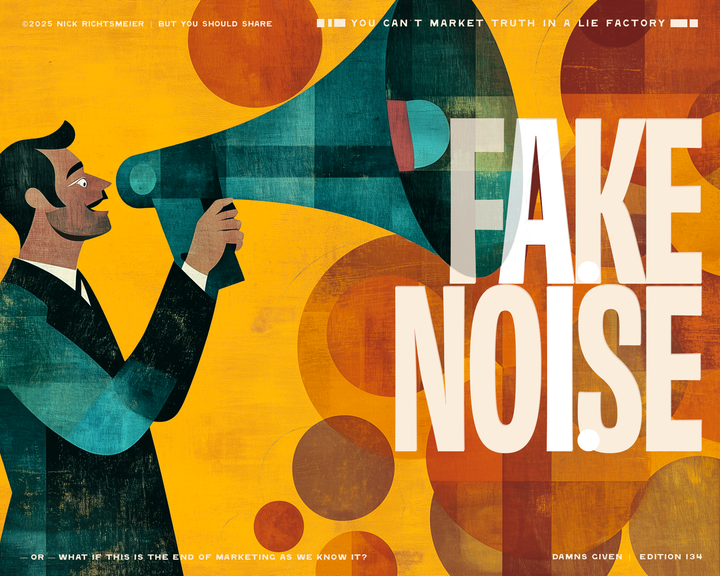Postponing your potential.
Leaders under-index the impact of their own decisions while over-indexing the impact of national or global headlines. So while your category is on its heels (trust us, it is), it's time to get aggressive.

FWD Edition 109
Not sure if you're ready to take the sword from the stone? Our Trust-Made Growth Assessment is the place to start.
The success of your business is about 90% you, 8% your category dynamics, 1.5% the larger economy, and .5% the election. Leaders under-index the impact of their decisions while over-indexing the impact of national or global headlines. And that bias is in the highest gear I've seen it in my lifetime.
Businesses biasing or delaying their plans for 2025 based on the election or larger economic winds are simply postponing their own potential.
With its "we could be great, but we'll get to it later" moves, I've rarely seen a business environment so frozen in time.
COVID wasn't like this, and 2009 wasn't like this. With fast-moving challenges, we leaders had to pivot quickly, solve problems, and rise to the occasion. And we were compensated well for it. My business doubled in revenue from 2009 to 2011 as I (at that time) provided advice to individuals and families navigating financial uncertainty.
My current business, CultureCraft, doubled yearly during COVID and after as we addressed the real challenges of that era quickly and with intention.
While amid a fundamentally strong economy, I see leaders playing to tired industry trends or "waiting it out," leaving us to ask—what exactly are you waiting for?
I'm back from a little publishing hiatus. I'm fired up to talk to you about why your growth agenda should be more aggressive than it has been in the last eight years, why the moves you make right now will define your 2030 outcomes, and how your entire competitive set is on its heels (in nearly every category).
YES, the economy is good.
The Economist, a long-term right-of-center publication, came out (among many other articles this month) with the clear and unflinching statement that the U.S. is at its nadir of strength and has set the pace for economic possibility around the globe.
As I said above, I think that "the economy" as a broad metric has a less than 10% impact on the ability of any sub-$50M revenue business to grow, but some folks need the encouragement to act with intention.
NO, marketing will not save you.
We often get confused as a marketing vendor, a case of mistaken identity I'm willing to accept. For many execs, "marketing" is some mysterious illness you contract when you stop getting enough referrals. It is devalued, wildly misunderstood, often a sinkhole of expense, all while employing people who have enormous capacity to do good work, but no strategic platform on which to do it.
Building your "digital capabilties" or "doing more leadgen" is a waste of time, attention, and money for a lot of businesses. They won't commit the dollars to do it at the necessary scale, they are chasing incumbant strategies (who have the brand advantage and the scale advantage), and their onboarding is not built to handle it so opportunity slips like sand through toddler's fingers.
Waking up in 2025 and thinking, "ok, now let's do marketing" will be a losing proposition for nearly everyone. Because the strategy isn't in place to actually make that work make money.
You've got other work to do first.
Maybe, "Scale" and "Growth" aren't the same thing.
Like moths to a flame, industries have flocked to mimic the tech-powered VC model of Silicon Valley. Not ironically, this has all happened while the SAAS industry (that great darling of the VC world) is in its second year of imploding in on itself, slashing budgets, scrapping for new rounds of funding, adding the "AI" moniker to every product feature in the slim hope they can retain relevance in an industry more commoditized than paper towels.
And yet, wealth, professional services, even education are taking cues from the flailing model, often in service to their new private equity overlords. If we wish to learn from the tech world's successes (and there are vital lessons there), then we must also learn from their failures.
Scaling (adding revenue so you can eventually cut people and processes once you are big enough to have your "efficiency" play) is very different from Growth. Growth is what we do when we are healthy and generative, when we earn a place in the hearts and minds of new customers.
There's a place for M&A, but as with so many things, treating it as a wholesale replacement for thinking well about growth is going to bite shortcutters in the ass.
SERIOUSLY, decide.
The plague of corporate strategy today is indecision—not just an unwillingness to make intentional decisions but a failed system of decision-making. We are at the tail end of a decade or more in which "leadership" has swung wildly back toward "management." C-suites are busy building reporting decks, checking KPIs, and looking for margin morsels anywhere they can find them.
This scarcity (and the large PE checks that empower it) has been mislabeled as a bad economy, when in most cases, it is simply bad leadership. Founders who have lost their founders' edge are trying to cosplay as CFOs.
Every organization between $3M and $50M needs to do three things in the next 90 days:
- What are the one or two ways we will commit to growing the business?
- How will we consistently align our CX (client experience) and EX (employee experience) to produce this outcome?
- How can we simplify and upgrade our product or service mix to be our category's elite/boutique provider rather than a copycat of industry norms?
I'm not too shy to tell you that all three require an outside perspective. Not your Traction coach who will show you how to fill out your Rocks form. He plays a different role.
Real perspective. The kind that questions you, challenges you, reveals your innate assumptions, and finds the genius in your firm that you've been unintentionally hiding.
Whole industries, the ones that Americans depend on the most, have been punting potential downfield. Will you continue with them?
NOW, get your Trust-Made™️ Growth score.
Start here. Get your self-tested Trust-Made Growth score, then spend 20 minutes with me looking under the hood. If you like what you hear, in 30 days my team will surface key answers to the above questions and you'll have a starting block to build the next 5 years on.
Let's go.
The Trust-Made Growth™️ Assessment was developed from years of engaging leaders who wanted to grow, but had hit repeatable ceilings. For ventures from $3M - $50M, including non-profits, that expect trust with their clients, employees, and prospects to drive growth, it is your one-stop assessment for what's happening, why, and what to do next.



